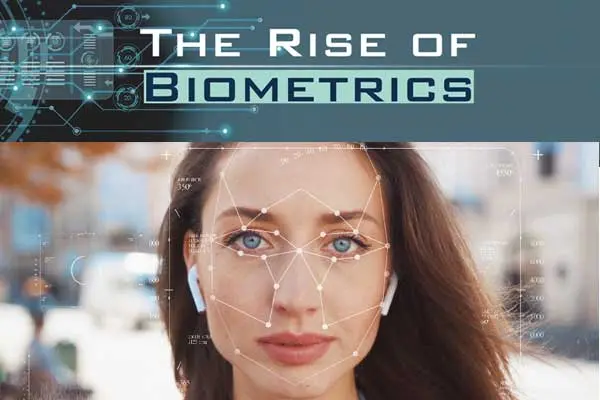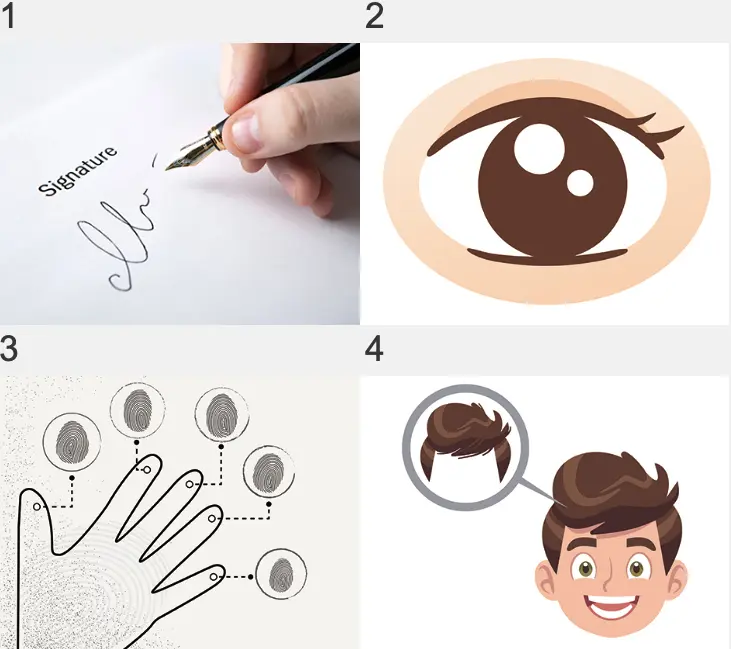
�ͪ�����: �H�ӤH�S�x��{���� The Rise of Biometrics
The Rise of Biometrics
#�\Ū����
9/22 �ѪR�^�y
�@�� Niall Longobardi
�\Ū�ɶ� 10����
ť���� ť��Ū
���Ϥ�X�B:
https://www.ivy.com.tw/newsLette ... 2023051714064350824
MP3:
�ͪ�����: �H�ӤH�S�x��{���� The Rise of Biometrics
�H�۬�V�ӶV�ĤJ�b�ڭ̪���`�ͬ����A�s�Φ��]�� �_�X�{�C
�ؿ� / More to Learn / Grammar Tips / ����½Ķ(& ����)
�\Ū����
As technology becomes increasingly ingrained in our daily lives, new forms continue to emerge all the time. One novel example that you might have heard about is biometrics. This technology is defined as a means of identifying and authenticating a person using biological characteristics. Common biometric types include fingerprint mapping, facial recognition, and retina scans. Biometrics can be used to either authenticate a person��s identity or identify individuals. Biometric authentication involves comparing a person��s data with their previously stored information. In contrast, biometric identification involves comparing a person��s data to that of others in a database to determine their identity.
Biometrics can be classified into two categories: physiological measurements and behavioral measurements. Physiological measurements can be further divided into two sets. Morphological identifiers refer to physical characteristics unique to an individual and that are unlikely to change, including fingerprints and eyes. For a biological analysis, DNA, blood, or urine samples are used. Contrary to physiological measurements, behavioral measurements look at a person��s actions, such as how they talk, walk, and even sign their name.
While biometrics might seem like a new, cutting-edge technology, it has actually been used for over 100 years. Around the turn of the 20th century, police forces in cities like London and Paris began using fingerprints to identify criminals. Law enforcement remains one of the most common fields where biometrics is employed. This includes using advanced technology like Automatic Biometric Identification Systems that can find criminals based on photos. Biometrics has also become widely used for immigration and border control. Many airports now have passengers scan their faces and fingertips upon entry and exit.
While advancements in biometrics can be helpful, there are still concerns. Not all biometric tests are 100% accurate, and some facial recognition programs have been known to misidentify people of color more frequently. Hopefully, as this technology further develops, it will be used in ways that prioritize beneficial applications for society.
1.According to the passage, how does biometric authentication differ from biometric identification?
(A) Biometric identification mainly uses morphological identifiers.
(B) Biometric identification is only used for immigration and border control.
(C) Biometric authentication compares a person��s information to that of other people.
(D) Biometric authentication compares a person��s information to what they previously stored.
2.Which two of the following are NOT morphological identifiers?

(A) 1 & 4. (B) 1 & 3. (C) 2 & 3. (D) 2 & 4.
3. According to the passage, in what way are airports using biometrics?
(A) They are using fingerprints to give people their tickets.
(B) Eye scans are taking place at domestic security checkpoints.
(C) Faces and fingertips are scanned to record who leaves or enters a country.
(D) Automatic Biometric Identification Systems are being used to find criminals at airports.
4. Which aspect of biometrics is NOT discussed in the passage?
(A) Worries about its accuracy.
(B) Examples of how it is used.
(C) Different types of it.
(D) Costs of utilizing it.
����: 1.D 2.A 3.C 4.D
��r���y��z
Words in Use
��
compare [kəm��p��r]
vi. �]�i�P�K�K�^�Ǽ�
vt. ��K�K��@
vt. & vi. ���
��
identify [a����d��ntə͵fa��]
vt. ���{�A�{�w�F�����P�@
vi. ��K�K�P�P�����]�P���� with �åΡ^
��
identification [a��͵d��ntəfə��ke��ən]
n. �����ҩ��]���i�ơA�Y�g�� ID�^
��
characteristic [͵kærəktə��r��st��k]
a. �嫬���]�һP���� of �åΡ^
n. �S�x
��
enforcement [��n��forsmənt]
n. ��I�A����
��
immigration [͵��mə��gre��ən]
n. ���~�]�ѥ~���J�^
��
beneficial [͵b��nə��f����əl]
a. ���q��
��
analysis [ə��næləs��s]
n. ���R
��
emerge [����mɝdʒ]
vi. �X�{�A�_�X�]�`�P���� from �åΡ^
��
automatic [͵��tə��mæt��k]
a. �۰ʪ�
��
database [��detə͵bes]
n. ��Ʈw
��
prioritize [pra������rə͵ta��z]
vt. ��⋯⋯���Ĥ@�u��
��
urine [��j��r��n]
n. �]�����Ϊk�^ pee
��
advancement [əd��vænsmənt]
n. �o�i�A�ﵽ
��
cutting-edge [ˌkʌt����ˈ��dʒ]
a. �y�ݪ��A�̷s��
��
ingrained [��n��grend]
a. �ڲ`���T��
��
physiological [͵f��z��ə��lɑdʒ��k!]
a. �Ͳz�]�ǡ^��
��
behavioral [b����hevjərəl]
a. �欰��
��
analyses [ə��næləs��z]
n. ���R�]�ƼƧΡ^
��
authenticate [�����c��nt��͵ket]
vt. �ҹ�
��
authentication [��͵�c��nt����ke��ən]
n. �ҹ�
��
morphological [͵m��rfə��lɑdʒəkəl]
a. �κA��
��
identifier [a����d��ntə͵fa��ɚ]
n. �ѧO�Ÿ�
��
fingertip [��f����gɚ͵t��p]
n. ���y
Practical Phrases
��
be unique to + �a�� ���Y�a��ҿW��
= be native to + �a��
= be indigenous to + �a��
Kiwi birds are unique to New Zealand. Nowhere else can you find them.
�f�k���æ����ҿW���A��L�a�賣�䤣��C
��
compare A to B �� A ��묰 B
Life is often compared to a long journey.
�H�ͱ`�Q��묰�@�q�������ȵ{�C
��
be classified into �Q�Ϥ��� A �M B
��
be beneficial to / for... ��......���q
Exercising on a daily basis is beneficial to your health.
�C�ѹB�ʹ�A�����d���n�B�C
��
compare A with B �N A �P B �@���
Some parents like to compare their kids with other kids.
���Ǥ������w���L�̪��Ĥl�M�O�H���Ĥl�@����C
��
contrary to... �P⋯⋯�ۤϡ]���O�^
Contrary to popular belief, that country is filled with beautiful landscapes.
�M�@��{�����P���O�A���Ӱ�a��B���O�����C
��
in contrast �۹�a�A�۸����U
Sarah is usually quiet. In contrast, her brother is always noisy.
��Գq�`�ܦw�R�C�۸����U�A�o�̧̤@�V�ܧn�C
��
be divided into �Q����⋯⋯
��
the turn of the + �ǼƵ� + century �b�Y�@���������
More to Learn
biometrics [ ͵ba��ə��m��tr��ks ] n. �ͪ�����
• With biometrics, you can unlock your smartphone by simply scanning your face or fingerprint.
���F�ͪ����ѡA�A�i�H²��a���y�y���Ϋ����Ӹ���A�����z������C
�r�� bio- ���u�ͪ��v�A�H�U���б`����r:
a. biological [ ͵ba��ə��lɑdʒ��k! ] a. �ͪ��Ǫ�
• We all have a biological clock that tells us when to sleep and wake up.
�ڭ̳����@�ӥͲz�����i�D�ڭ̦�ɸӺ�ı�M�_�ɡC
b. biology [ ba����ɑlədʒ�� ] n. �ͪ�(��)
• My mother��s love for gardening fostered my interest in biology.
�ڶ�����������ߦn���i�F�ڹ�ͪ��Ǫ�����C
c. biofuel [ ˈba��ə��fj��əl ] n. �ͽ�U��
biodiesel [ ˈba��ə��ˌdiːzl ] n. �ͽ��o(�ѴӪ��o�ΰʪ��תջs�����U��)
• Biofuels are fuels made from plants or animals.
�ͽ�U�ƬO�δӪ��ΰʪ��s�����U�ơC
d. biodiversity [ ba��o͵da����vɝsət�� ] n. �ͪ��h�˩�
• Madagascar is famous for its biodiversity.
���F�[���[�H��ͪ��h�˩ʻD�W�C
e. biodegradable [ ��ba��od����gredəb! ] a. ��i��ͪ����Ѫ�
• Some plastic bags are biodegradable.
���Ƕ콦�U��i��ͪ����ѡC
Grammar Tips
Many airports now have passengers scan their faces and fingertips upon entry and exit.
have ���ϧаʵ��ɡA���U�C�T�إΪk:
�� have ���u�s(�Y�H���Y��)�v�A�i�� make �N���A���[�����A�A�H��ΰʵ��@�ɻy(����Y�����Ϊk)�A �Φ��U�C�y��:
have + ����(�q�`���H)+ ��ΰʵ�
�s⋯⋯(�Y�H)��⋯⋯
= make + ���� + ��ΰʵ�
= get + ���� + to + ��ΰʵ�
• Elaine had / made her son fix her phone.
= Elaine got her son to fix her phone.
�콬�s��l�צo������C
�� have ��i���u��(�Y��)⋯⋯�v�A�i�� get �N���A���ɫh�H�L�h�����@�����ɻy�A�Φ��U�C�y��:
have + ���� + �L�h����
��⋯⋯(�Q)⋯⋯(�`���ХL�H�N�ҡA�ӫD�˦۰�)
= get + ���� + �L�h����
• Andy had / got his car washed over the weekend.
�w�}�b�g�����ɭ����H��L�����~�n�F�C
�� have �[������A����i���{�b�����@�����ɻy�A�j �հʧ@�۵M�o�ͩΫ���i��C�y���p�U:
have + ���� + �{�b���� ��/��⋯⋯�@��(��)⋯⋯
• The singer��s performance had her fans screaming and jumping in the arena.
���W�q�⪺���t���o�������b�|���̤S�s�S���C
�����D
Ken had one of his teeth _____ last Thursday.
(A) pull (B) pulled (C) pulling (D) be pulled
����:B
����½Ķ(& ����)
�H�۬�V�ӶV�ĤJ�b�ڭ̪���`�ͬ����A�s�Φ��]�� �_�X�{�C�@�ӧA�i�ിť�L���s�o�Ҥl�N�O�ͪ����ѧN�C �o�اN�Q�w�q���ϥΥͪ��S�x�ӿ��ѩM���Ҥ@�ӤH���� �k�C�`�����ͪ����������]�A�����M�g�B�y�����ѩM������ ���y�C�ͪ����ѥi�H�Ψ����Ҥ@�ӤH�������A�]�i�H�Ψӿ� �O�H�C�ͪ��������ҥ]�t�N�@�ӤH����ƻP����e�x�s���� �ƶi����C�۸����U�A�ͪ������ѧO�h�O�N�@�ӤH����� �P��Ʈw����L�H����ƶi�����A�H�T�w�䨭���C
�ͪ����ѥi�H��������:�Ͳz���q�M�欰���q�C�Ͳz ���q�i�H�i�@�B������աC���A�ѧO�ŬO���C�ӤH�W�S���� ��S�x�A�B���ӥi����ܪ��A�]�A�����M�����C�b�ͪ����R ���A�h�ϥ� DNA�B��G�Χ��G�˥��C�P�Ͳz���q�ۤϡA�� �����q�ݪ��O�@�ӤH���欰�A�Ҧp�L�̦p�ܡB�����A�� �ܬOñ�W�C
���M�ͪ����ѩγ\�ݰ_�ӹ��O�@�طs���y�ݧN�A���� �ڤW���w�g�Q�ϥΤF�@�ʦh�~�C�b�G�Q�@�����楪�k�A�۴� �M�ھ���������ĵ��}�l�ϥΫ����ѧO�o�ǡC���k�������M �O�̱`�ϥΥͪ����ѧN����줧�@�C�o�]�t�ϥί���Q�� �Ӥ��ӴM��o�Ǫ����i�N(�p�۰ʥͪ������ѧO�t��)�C �ͪ����Ѥ]�w�s�x�Ω��M��Һި�C�{�b�A�\�h������ �n�D���ȥX�J�Үɱ��y�L�̪��y���M���y�C
���ަb�ͪ����ѧN�W���i�B�i������U�A�����M�s �b�@�ǰ��D�C�ëD�Ҧ��ͪ����Ѵ��ճ��O 100% �ǽT���A�� �B�����y�����ѵ{���w���b����H�ت����ѤW�ɱ`�X���C�� ���H�۳o���N���i�@�B�o�i�A������u���H����|���Ϊ� �覡�Q���ΡC
1. �ھڥ���A�ͪ��������ҩM�ͪ������ѧO���P?
(A) �ͪ������ѧO�D�n�ϥΫ��A�ѧO�šC
(B) �ͪ������ѧO�u�Ω��M��Һި�C
(C) �ͪ��������ұN�Y�H����T�P�L�H����T���C
(D) �ͪ��������ұN�Y�H����T�P�䤧�e�x�s����T�@���C
2. �U�C����̤��O���A�ѧO��?
(A) 1 & 4.
(B) 1 & 3.
(C) 2 & 3.
(D) 2 & 4.
3. �ھڥ���A�����O�p��ϥΥͪ����Ѫ�?
(A) �L�̨ϥΫ����ӵ��H�̾����C
(B) �������y�b�C�Ӱꤺ�w���I�����b����C
(C) ���y�y���M���y�ӰO���X�J�Ҫ��H�C
(D) �۰ʥͪ������ѧO�t�Φb�����Q�ΨӴM��o�ǡC
4. ����å��Q�ר�ͪ����Ѫ����@�ӭ��V?
(A) ���ǽT�ʪ���~�C
(B) ��p��ϥΪ��Ҥl�C
(C) ���P�������ͪ����ѡC
(D) �ϥΥͪ����Ѫ������C